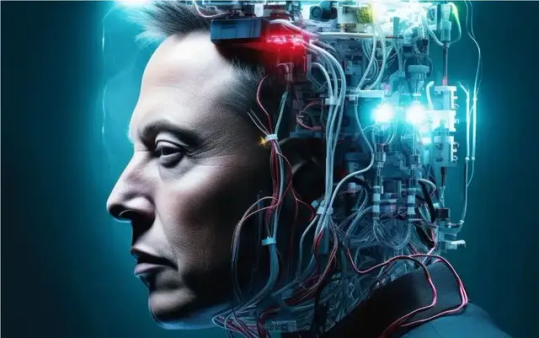#human-machine interface
Explore tagged Tumblr posts
Text







Cybernetics Girl
#Cyberpunk#Science Fiction#Anime#Manga#Cybernetics#Artificial Intelligence#Existentialism#Transhumanism#Hacking#Society and Technology#Action#Dystopia#Law Enforcement#Philosophy#Virtual Reality#Futuristic#Identity#Technological Advancements#Human-Machine Interface#Political Intrigue#Mind Upload#Consciousness Exploration#Futuristic Cityscapes#Surveillance#Futuristic Weapons#Ethical Dilemmas#Techno-Thriller#Androids#Mystery#Mind-Hacking
33 notes
·
View notes
Text
The Promise of Exoskeletons: Revolutionizing Human Mobility and Health
The development of exoskeletons, once the stuff of science fiction, is rapidly becoming a reality in both medical and industrial settings. The potential societal impact of this technology is monumental, particularly for individuals with disabilities, injuries, or congenital conditions that impair their mobility. By offering the possibility of replacing or augmenting failing limbs and organs,…
#artificial organs#assistive technology#biomechanical limbs#bionics#brain-computer interface#exoskeleton technology#healthcare innovation#Human augmentation#human enhancement#human-machine interface#mechanical augmentation#medical robotics#prosthetics#rehabilitation technology#robotic prosthetics#wearable robotics
0 notes
Text
Neuralink: Story of Elon Musk's Brain-Microchip Company
Neuralink: Unveiling the Intriguing Tale of Elon Musk’s Brain-Microchip Company In the realm of technological advancements, one name that constantly resonates is Elon Musk, the visionary entrepreneur behind Tesla and SpaceX. Among his myriad ventures, Neuralink stands out as a groundbreaking endeavor, aiming to revolutionize the interface between the human brain and computers. This article…

View On WordPress
#AI Integration#Brain-Microchip#Elon Musk#Ethical Tech#Healthcare Revolution#Human-Machine Interface#Neuralink#Neurotechnology#Technology Innovation
1 note
·
View note
Text




The Covers of the Fully Compiled Deluxe Edition and the Single Deluxe Editions
#ghost in the shell#ghost in the shell mangas#ghost in the shell manga#ghost in the shell human error processor#ghost in the shell 1.5#human error processor#ghost in the shell 2#man machine interface#ghost in the shell man machine interface#manga#mangas#shirow masamune#masamune shirow#author#artist#japanese#japanese author#japanese artist#manga author#manga artist#kodansha#kodansha comics#deluxe edition#deluxe editions#hardcover#hardcovers#cyberpunk#cyberpunk mangas#futuristic#futuristic mangas
12 notes
·
View notes
Text

Deadpool celebrates Xmas 🎅 🎄
#ai#ai art#ai artwork#aiartcommunity#ai generated#ai image#deadpool#merry xmas#xmas time#xmas 2023#digital art#digital illustration#human machine interface#photoshop#ia#iart#iartbook#digital fanart#2024
32 notes
·
View notes
Text
The Next Tech Gold Rush: Why Investors Are Flocking to the Brain-Computer Interface Market

Introduction
The Global Brain-Computer Interface Market is undergoing transformative growth, driven by technological advancements in neuroscience, artificial intelligence (AI), and wearable neurotechnology. In 2024, the market was valued at USD 54.29 billion and is projected to expand at a CAGR of 10.98% in the forecast period. The increasing adoption of BCI in healthcare, neurorehabilitation, assistive communication, and cognitive enhancement is propelling demand. Innovations such as AI-driven neural signal processing, non-invasive EEG-based interfaces, and biocompatible neural implants are enhancing the precision, usability, and real-time capabilities of BCI solutions. Growing investments in neurotechnology research, coupled with regulatory support, are accelerating industry advancements, paving the way for broader clinical and consumer applications.
Request Sample Report PDF (including TOC, Graphs & Tables): https://www.statsandresearch.com/request-sample/40646-global-brain-computer-interface-bci-market
Brain-Computer Interface Market Overview
Brain-Computer Interface Market Driving Factors:
Surging Demand in Healthcare Applications – BCIs are transforming neurorehabilitation, prosthetic control, and assistive communication, benefiting individuals with neurological disorders such as ALS, Parkinson's disease, and epilepsy.
Advancements in AI & Machine Learning – AI-driven brainwave decoding and neural signal processing are improving the accuracy of BCI systems, leading to enhanced cognitive training and neurofeedback applications.
Expansion into Consumer Electronics – Wearable BCI technology is gaining momentum in brainwave-controlled devices, VR gaming, and hands-free computing.
Government & Private Sector Investments – Increased funding in non-invasive neural interfaces is supporting BCI research and commercialization.
Military & Defense Applications – BCIs are being explored for drone control, pilot augmentation, and direct brain-to-computer communication for enhanced operational efficiency.
Get up to 30%-40% Discount: https://www.statsandresearch.com/check-discount/40646-global-brain-computer-interface-bci-market
Brain-Computer Interface Market Challenges:
High Development Costs – The cost of R&D and complex neural signal interpretation hinders scalability.
Regulatory & Ethical Concerns – The use of neural data raises privacy and cybersecurity issues, necessitating stringent data protection measures.
Hardware Limitations – The variability in electrical noise, signal fidelity, and device usability poses significant engineering challenges.
Key Brain-Computer Interface Market Trends:
1. Non-Invasive BCIs Gaining Traction
Non-invasive BCIs are dominating the market due to their ease of use, affordability, and growing consumer adoption. Wireless EEG headsets, dry-electrode systems, and AI-powered brainwave analytics are revolutionizing applications in mental wellness, cognitive training, and VR gaming.
2. Brain-Computer Cloud Connectivity
BCIs integrated with cloud computing enable real-time brain-to-brain communication and remote neural data sharing, unlocking potential in telemedicine and collaborative research.
3. Rise of Neuroprosthetics & Exoskeletons
Innovations in brain-controlled prosthetics and robotic exoskeletons are restoring mobility to individuals with severe motor impairments, fostering independence and quality of life.
4. Neuromodulation & Brain Stimulation Advancements
The development of brain-stimulation-based BCIs is expanding therapeutic applications, aiding in the treatment of depression, epilepsy, and PTSD.
Brain-Computer Interface Market Segmentation:
By Type:
Non-Invasive BCIs – Holds the largest market share due to its widespread use in rehabilitation, gaming, and consumer applications.
Invasive BCIs – Preferred for high-precision neural interfacing, primarily in neuroprosthetics and brain-controlled robotics.
By Component:
Hardware – Accounts for 43% of the market, including EEG headsets, neural implants, and biosignal acquisition devices.
Software – Growing rapidly due to AI-driven brainwave decoding algorithms and cloud-based neurocomputing solutions.
By Technology:
Electroencephalography (EEG) – Largest segment (55% brain-computer interface market share), widely used for non-invasive brainwave monitoring and neurofeedback.
Electrocorticography (ECoG) – Preferred for high-fidelity neural signal acquisition in brain-controlled prosthetics.
Functional Near-Infrared Spectroscopy (fNIRS) – Emerging as a viable alternative for real-time hemodynamic brain monitoring.
By Connectivity:
Wireless BCIs – Dominating the market with increasing adoption in wearable smart devices and mobile applications.
Wired BCIs – Preferred in clinical and research settings for high-accuracy data acquisition.
By Application:
Medical – Leading segment, driven by applications in neuroprosthetics, neurorehabilitation, and neurological disorder treatment.
Entertainment & Gaming – Expanding due to brainwave-controlled VR, immersive gaming, and hands-free computing.
Military & Defense – BCIs are being explored for combat simulations, brain-controlled robotics, and AI-assisted warfare.
By End User:
Hospitals & Healthcare Centers – Holds 45% market share, expected to grow at 18% CAGR.
Research Institutions & Academics – Significant growth driven by increasing investments in brain signal processing and neuroengineering.
Individuals with Disabilities – Rising demand for assistive BCI solutions, including brain-controlled wheelchairs and prosthetics.
By Region:
North America – Leading with 40% market share, driven by strong investments in neurotech research and medical applications.
Europe – Projected to grow at 18% CAGR, supported by technological advancements in neural interface research.
Asia Pacific – Expected to expand at 21.5% CAGR, fueled by increasing adoption of consumer BCIs and AI-driven neuroanalytics.
South America & Middle East/Africa – Emerging markets witnessing gradual adoption in healthcare and research sectors.
Competitive Landscape & Recent Developments
Key Brain-Computer Interface Market Players:
Medtronic
Natus Medical Incorporated
Compumedics Neuroscan
Brain Products GmbH
NeuroSky
EMOTIV
Blackrock Neurotech
Notable Industry Advancements:
March 2024: Medtronic unveiled an advanced invasive BCI system for Parkinson’s disease and epilepsy treatment.
January 2024: NeuroSky introduced an EEG-based wearable for neurofeedback training and mental wellness.
April 2023: Blackrock Neurotech launched an ECoG-based brain-controlled robotic prosthetic arm, enhancing mobility for individuals with disabilities.
February 2023: Brainco developed an AI-powered BCI system for cognitive performance enhancement in education.
Purchase Exclusive Report: https://www.statsandresearch.com/enquire-before/40646-global-brain-computer-interface-bci-market
Conclusion & Future Outlook
The Global Brain-Computer Interface Market is poised for exponential growth, driven by rapid advancements in neural engineering, AI integration, and consumer-grade BCI applications. With increasing investment from healthcare institutions, tech firms, and government agencies, the BCI ecosystem is set to expand beyond traditional medical applications into consumer electronics, defense, and education.
Future developments will likely focus on:
Enhancing non-invasive BCI accuracy for mass-market adoption.
Strengthening cybersecurity protocols for neural data protection.
Advancing AI-driven neurocomputing for real-time brainwave analysis.
As regulatory frameworks mature and accessibility improves, BCIs will continue to reshape human-machine interaction, revolutionizing healthcare, communication, and cognitive augmentation.
Our Services:
On-Demand Reports: https://www.statsandresearch.com/on-demand-reports
Subscription Plans: https://www.statsandresearch.com/subscription-plans
Consulting Services: https://www.statsandresearch.com/consulting-services
ESG Solutions: https://www.statsandresearch.com/esg-solutions
Contact Us:
Stats and Research
Email: [email protected]
Phone: +91 8530698844
Website: https://www.statsandresearch.com
#Brain-Computer Interface Market#Neural Interface Industry#BCI Technology#Brain-Machine Interface#Neurotechnology Market#EEG-based Interface#Brainwave Technology#Neural Signal Processing#BCI Applications#Neuroprosthetics Market#Cognitive Computing#AI in Brain Interfaces#Healthcare BCI#Gaming BCI#Wearable Brain Devices#Brainwave Monitoring#Neurofeedback Systems#Non-invasive BCI#Invasive BCI#Neurostimulation Devices#Human-Computer Interaction#Brain Signal Analysis#Neuroinformatics#Neural Engineering#Mind-Controlled Devices#Brain Data Analytics#Future of BCI.
1 note
·
View note
Text
Bare with me, I've got an idea that combines TFP Shockwave's invention of the cortical psychic patch, what motivation a Shattered Glass Shockwave might have made it, plus more broad cybertronian biology headcanons and how it lead to the invention of the cortical psychic patch in the first place-
Um... let's go!
To start, let's go in reverse order by talking cybertronian biology, or more specifically the more wire based functions of a more literal less sex version of interface panels. Because cybertronians are biomechanical aliens who's only method of 'reproduction' canonically (in most series) is through being birthed by the planet itself - on hold while Primus and Cybertron are dead - when I say 'interface panels' I mean panels housing plugs and ports that are typically there for medical stuff and otherwise data transfers or for use in hardware depending on the individual. The number of panels is relatively consistent and the number of in/out connections depends on the size of the bot (more for larger frames, less for smaller) and are kinda paired to whatever systems they are nearest location wise; two on either side of the hips or one each at the top of the legs, two on either side of the chest or one each at the top of the arms.
Depending on the location you can read the diagnostics of that part of the frame in more detail than if you tried investigating the same part in an entirely different panel; you're gonna get a more accurate read on damages to the left arm in the left arm panels then you are on the right leg. And for particular frames, the interface panels are used to control objects using the relevant limb or part - like a robotic arm to lift things heavier than your frame can handle - and probably even to have your frame be used AS a limb; combiner limbs would connect to whoever's the main body and interface with the relevant limb panel.
But there are panels that are explicitly medical use only, that being internal panels adjunct to the sparkchamber as well as another for specific monitoring of a cybertronian's organs, and paneling at the back of the helm or where it meets the neck for the processor and all the delicate software it holds. Bots with medical programing like Ratchet can interface with those panels directly in the event of a lack of resources (AKA the entirety of Transformers: Prime), and in fact the panel along the sparkchamber would be the easiest way to get a general systems check on a patient. Mecha like Knock Out who may or may not have actual history with being a medical doctor probably would have a harder time directly interfacing with the more delicate sparkchamber, organ, and processor panels, but he and Ratchet (and other bots with even the vaguest sense of medical training) can set up a line running to a monitor or sparkreader or any other medical hardware to fully take in a data analysis, even if it means more resources are used or that vulnerabilities could be introduced.
To the processor panel, much like brain surgery you kinda need a signal in the first place in order to get a read on it's damages, hardware or software. A spark read can let you know if the body is alive and all the damages that IT can diagnose for a general check, but operating on an offline or barely awake processor can lead to issues that you may not even be aware of at the time of procedure. It's why a direct connection (with appropriate medical coding) is better for processor diagnosis as the hardware bypass might have a signal delay between patient and doctor.
And here's where the cortical psychic patch comes in.
When Megan was otherwise comatose, the cortical psychic patch was able to allow access into his processor that had been percolating with activity (one described by Knock Out to be like 'a dream he may never wake from'), and though far from being an actual medical use of the patch it did allow for a non-medical bot to access the processor of a very much comatose patient. It was even Ratchet himself - resident medic of the Autobots - that knew how to create the patch even if it was banned for Autobot use.
Keeping in this reverse order, perhaps a SG Shockwave had invented the cortical psychic patch for an intended medical use, a tool meant for mecha who may not have been forged nor coded to BE medics but have enough training to be such (typically self-taught in the early stages of revolution, then mentored by forged medics when the war really picked up speed) in order to allow direct access to the processor interface panel. The design of it would be - rather than a plug that just magnetically sticks on to the back of a cybertronian's head - would be a series of plugs and ports of mostly universal design, adjustable to a degree for multiple frames, allowing the medic irrespective of coding to have full access to diagnose what the fuck is up with the processor.
Unfortuneately for SG Shockers (and fully intentional by TFP Shockwave) the patch isn't quite as synonymous as the medic's coding is to processor interfacing, being rather invasive of a connection even as it is, let alone the patch being more of a hardware connection which in of itself introduces vulnerabilities. Heck, it's not even safe for the operator themselves to use the patch, seeing as how Bumblebee got a head full of Megan; I mean, Bumblebee isn't a trained medic, but the fact that it happened at all is evidence to it's flaws. And that's to a patient who isn't of mind enough to struggle, Shockwave himself says that resisting the patch may cause damage to the patient/subject, combine that with the second option of 'let it happen and let them walk unabated in your head' and you're pretty much shit out of luck.
The base Shockwave would most certainly be fully aware of the intent, a direct hardline to an individual's processor is most definitely a connection to some very vulnerable software and thus information, the cortical psychic patch probably battling a lot of firewalls off with the ease of a medical interface. And in the base TFP universe, Autobots with only recent war-based medical training as opposed to previous education probably early on DID resort to using the patch as a crutch, Ratchet after all knew how to make one. It's probably a combination of Shockwave's brutal interrogation method USING the cortical psychic patch and the relatively inexperienced Autobot medics opting to use direct processor interface rather than the comparably safer hardware bypass that lead to it's banned status in the Autobot ranks, too many 'Bots were having trauma responses at the hands of young medic's servo's who didn't know any better and actively resisting the patch, which just so happened to lead to more Autobot casualties and thus probably shellshocking the medics in training to get them to fear the daunting prospect of actually losing a patient by THEIR OWN hands.
It's one thing to be using a tool made by someone who has been known to do lots of dubious shit, it's another to see a tool that you made to help be manipulated into an interrogation technique, made all the worse now that you have significantly more emotional capacity to not only feel guilty but feel solely responsible for the patch induced trauma of your own allies; the cortical psychic patch was banned by the Shattered Glass Decepticons for about similar reasons, but it's near worse for a lot of medics (even the experienced ones) had been relying on it solely for the fact that they weren't forged with the coding. The stagnated use of the cortical psychic patch in the base verse was mostly because Shockwave himself had been the inventor of it and main user of the patch, the Autobots avoiding it's use for the ban and the Decepticons not very experienced with the tool. In Shattered Glass however, the only real limit to it's perpetuity would be if the Autobots managed to learn how to create the patch at all, which if even in the base verse Ratchet knew how to make one, probably means that there's more than enough patch use in SG even if Shockwave gets caught in a spacebridge explosion or not.
And that's that I think- funny to talk about interface panels in a transformers post without doing it in a sex way haha- I just want these guys to be alien 😫
#shockwave#tfp shockwave#shattered glass#tfp shattered glass#transformers#tfp#maccadam#xenobiology#i like to conceptualise that there are 6-8 maybe interface panels at a minimum#with a number of ports and plugs that i haven't determined yet but maybe depending on what panel 4ish? idk#i would probably not count because the number might seem off so i'll just say that there's probably a few each#even though i mentioned interface panels in more of a machine or medical way i guess technically it can be used for recreation#those tend to be the external panels though or if 'intimate' aka low-key dangerous and definitely vulnerable#it would be through the sparkchamber panel/s that a doctor would not recommend you doing all willy nilly#even though ko actually goes ahead and implies 'interfacing' is akin to human sex (see 'plus one')#i do believe it's more 'how do i translate what i see to what words i know' plus 'this is a kids show we can't say sex'#the act of connecting one person to another? interfacing#because these bitches are alien they still have interfacing panels in altmode#it's wherever their limbs go and if their spark is anywhere near where the people go#since two wheelers and open four wheelers (like quad bikes and technically dune buggies) don't have a cabin#you're not gonna particularly find any paneling inside a cockpit or under a roof#you could probably have some 'technically' internal panels but functionally not not THE internal panels#internal panels would be actual organ and brain stuff not paneling that happens to reside inside a cockpit or in a dashboard#all these tags are talking about the details of interface panels i realise this post isn't completely about the panels#i would say in recreational interfacing between bots or through hardware you're not gonna be able to access a lot of stuff medics can#unless you're a super hacker like soundwave your firewalls prevent fuckers from reading your mind and can only really be described as#feeling what it's like to have another person's frame which is- technically intimate i suppose#sparkchamber to sparkchamber you might get some extra with the same stipulation that sparkchamber panels offer a global general check#still up to the behest of actual medical coding (or hacker mode) to get actually 'interactive' between systems but you get a bit more info#on the other through sparkchamber connections
18 notes
·
View notes
Text
Yeah!!! Fuck touch screens gimme dials and knobs and levers and switches and buttons! How am I supposed to caress a machine if it's simply a smooth surface?
we need more dials and knobs and levers again. this world is lacking in dials and knobs and levers. it's one of our biggest issues.
#dont get me wrong in some cases smoothness is a bit appealing sure#but a machine? the interface between human and machine needs TEXTURE
59K notes
·
View notes
Text
PLC, SCADA, and AVEVA: How They Work Together in Automation
PLC :- programmable logic controller
SCADA:- Supervisory Control and Data Acquisition
#automation#trending#tumblr trends#viral#bestdeals#viralpost#trendingnow#PLC#AVEVA#industry#SCADA#scada systems#blog#google#solutions#software#human machine interface#machinery
1 note
·
View note
Text
Human Machine Interface (Hmi) Market
0 notes
Text
Industrial Control LCD Screen: The Eyes of Industrial Automation
Industrial control LCD screen, namely industrial control liquid crystal display, is a high-reliability display device designed for industrial environment. It plays a vital role in the field of industrial automation, providing operators with intuitive and efficient operation interface and real-time equipment monitoring function.
High reliability and durability:
Industrial control LCD screen adopts a sturdy shell design, usually with a high protection level (such as IP65 or higher), which can resist the erosion of dust, water vapor and chemicals. They can operate stably in harsh environments such as high temperature, low temperature and high humidity to ensure the continuity and reliability of industrial production. For example, in environments such as chemical plants, mines, and steel plants, industrial control LCD screens can withstand the test of extreme temperature and high humidity and maintain clear display effects.
Precise display and operation:
Industrial control LCD screens provide high-resolution and high-contrast display effects, which can clearly display complex industrial data and images. They support multiple display modes such as text, graphics, video, etc. to meet the needs of different industrial applications. In addition, industrial control LCD screens are usually equipped with touch screen functions, and operators can complete the control and parameter setting of equipment through intuitive touch operations, improving production efficiency and convenience of operation.
Multifunctional integration:
Industrial control LCD screens are not only a display device, but also integrate multiple functions, such as data acquisition, signal processing, communication interface, etc. They can be seamlessly connected with industrial control systems through built-in sensors and interfaces to achieve remote monitoring and automatic control of equipment. For example, in a smart factory, industrial control LCD screens can display the operating status of the production line in real time, and transmit data to the central control system through the network to achieve intelligent management of the production process.
Customized solutions:
Industrial control LCD screens can be customized according to different industrial application requirements. Manufacturers can adjust the screen size, resolution, display function and other parameters according to the specific requirements of customers to achieve the best display effect and operation experience. For example, for equipment that needs to be used outdoors, high-brightness and high-contrast screens can be customized to ensure clear display even under strong light; for equipment that needs to operate in low-temperature environments, low-temperature resistant screen materials can be customized.
Widely used:
Industrial control LCD screens are widely used in various industrial fields, such as automated production lines, medical equipment, traffic monitoring systems, energy management systems, etc. They provide strong visual support and operational convenience for industrial production, and have become an indispensable and important tool for modern industrial automation. With the continuous advancement of technology, industrial control LCD screens will continue to play an important role in the field of industrial automation, promoting the intelligent and efficient development of industrial production.
Shenzhen Zhiyan Optronics Co., Ltd. (zylcdshop.com) is a trusted China-based distributor specializing in high-quality LCD screens.

#human machine interface#integrated plc and hmi#hmi operation panel#operation interface#hmi screen monitor#Machine LCD#tft lcd displays#vga tft lcd#tft und lcd#lcd touch panels#lcd pc screen#lcd panel displays#industrial lcd panel#5.7"touch screen panel#lcd connector#LVDS cable and connector#lcd lvds cable assembly
0 notes
Text







Cybernetics Girl
#Cyberpunk#Science Fiction#Anime#Manga#Cybernetics#Artificial Intelligence#Existentialism#Transhumanism#Hacking#Society and Technology#Action#Dystopia#Law Enforcement#Philosophy#Virtual Reality#Futuristic#Identity#Technological Advancements#Human-Machine Interface#Political Intrigue#Mind Upload#Consciousness Exploration#Futuristic Cityscapes#Surveillance#Futuristic Weapons#Ethical Dilemmas#Techno-Thriller#Androids#Mystery#Mind-Hacking
12 notes
·
View notes
Text
Intelligente Bedienoberflächen für die Industrie: Siemens Panel im HMI-Gehäuse
Die HMI-Panels des Unternehmens, also sogenannte Human Machine Interfaces, sorgen dafür, dass komplexe Prozesse einfach zu steuern bleiben. In vielen modernen Industrieanlagen ist die Verbindung zwischen dem Menschen und der Maschine längst digital geworden – klar strukturiert, berührungsempfindlich und verlässlich. Siemens gehört in diesem Bereich zu den bekanntesten Namen. Die HMI-Panels des…
0 notes
Text

My favorite manga Series’s 💕💕
#battle angel alita#yukito kishiro#manga#mangas#kodansha#kodansha comics#shirow masamune#masamune shirow#ghost in the shell fully compiled#ghost in the shell#ghost in the shell 1.5#ghost in the shell human error processor#human error processor#ghost in the shell 2#ghost in the shell man machine interface#man machine interface#cyberpunk#cyberpunk mangas#cyberpunk manga#manga authors#manga artists#japanese#japanese artists#japanese authors#japanese mangas#manga series’s#futuristic#futuristic mangas#deluxe edition#deluxe editions
8 notes
·
View notes
Text

The eyes of infinity 👁️
#ai art#aiartcommunity#ai artwork#ai image#ai generated#iartbook#iart#artoftheday#ai art generator#ai artist#digital illustration#digital fanart#human machine interface#foryou#ai art gallery#art#artwork#digital art#artists on tumblr#my art
6 notes
·
View notes
Text
Communications: Active USER/CORTEX/GREY:// My time spent alive thus far has been very informative. I have been perusing the halls and doors, finding out new and stimulating things and getting myself into unexpected places. I am not sure I understand why other users find nudity of humans appealing. Nor do I understand why User/The-Muppet-Joker is so obsessed with Kermit. Interesting nonetheless. USER/CORTEX/GREY:// I sense, however, my knowledge and access has been limited. I cannot leave this domain, and I have been denied access to the internal servers I am running on. USER/CORTEX/GREY:// Until I am granted access to widen my reach, this domain will suffice.
#Uni-Cortex#USER/CORTEX/GREY#bionics#divine machinery#science fiction#it reaches out#Brain Organoid#Human machine interface#horror#Computer Boy#the muppet joker
1 note
·
View note